Ming-Wei Chang
KITTEN: A Knowledge-Intensive Evaluation of Image Generation on Visual Entities
Oct 15, 2024



Abstract:Recent advancements in text-to-image generation have significantly enhanced the quality of synthesized images. Despite this progress, evaluations predominantly focus on aesthetic appeal or alignment with text prompts. Consequently, there is limited understanding of whether these models can accurately represent a wide variety of realistic visual entities - a task requiring real-world knowledge. To address this gap, we propose a benchmark focused on evaluating Knowledge-InTensive image generaTion on real-world ENtities (i.e., KITTEN). Using KITTEN, we conduct a systematic study on the fidelity of entities in text-to-image generation models, focusing on their ability to generate a wide range of real-world visual entities, such as landmark buildings, aircraft, plants, and animals. We evaluate the latest text-to-image models and retrieval-augmented customization models using both automatic metrics and carefully-designed human evaluations, with an emphasis on the fidelity of entities in the generated images. Our findings reveal that even the most advanced text-to-image models often fail to generate entities with accurate visual details. Although retrieval-augmented models can enhance the fidelity of entity by incorporating reference images during testing, they often over-rely on these references and struggle to produce novel configurations of the entity as requested in creative text prompts.
Imagen 3
Aug 13, 2024Abstract:We introduce Imagen 3, a latent diffusion model that generates high quality images from text prompts. We describe our quality and responsibility evaluations. Imagen 3 is preferred over other state-of-the-art (SOTA) models at the time of evaluation. In addition, we discuss issues around safety and representation, as well as methods we used to minimize the potential harm of our models.
Can Long-Context Language Models Subsume Retrieval, RAG, SQL, and More?
Jun 19, 2024


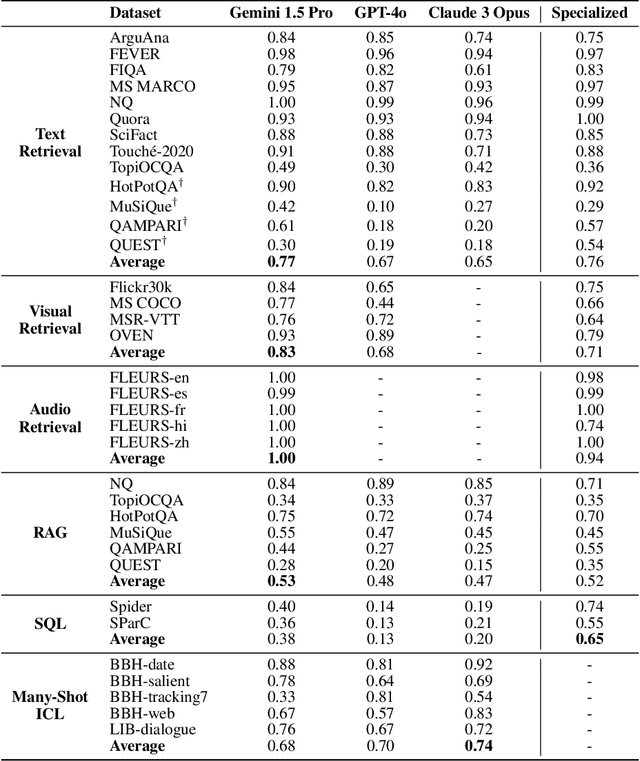
Abstract:Long-context language models (LCLMs) have the potential to revolutionize our approach to tasks traditionally reliant on external tools like retrieval systems or databases. Leveraging LCLMs' ability to natively ingest and process entire corpora of information offers numerous advantages. It enhances user-friendliness by eliminating the need for specialized knowledge of tools, provides robust end-to-end modeling that minimizes cascading errors in complex pipelines, and allows for the application of sophisticated prompting techniques across the entire system. To assess this paradigm shift, we introduce LOFT, a benchmark of real-world tasks requiring context up to millions of tokens designed to evaluate LCLMs' performance on in-context retrieval and reasoning. Our findings reveal LCLMs' surprising ability to rival state-of-the-art retrieval and RAG systems, despite never having been explicitly trained for these tasks. However, LCLMs still face challenges in areas like compositional reasoning that are required in SQL-like tasks. Notably, prompting strategies significantly influence performance, emphasizing the need for continued research as context lengths grow. Overall, LOFT provides a rigorous testing ground for LCLMs, showcasing their potential to supplant existing paradigms and tackle novel tasks as model capabilities scale.
Gecko: Versatile Text Embeddings Distilled from Large Language Models
Mar 29, 2024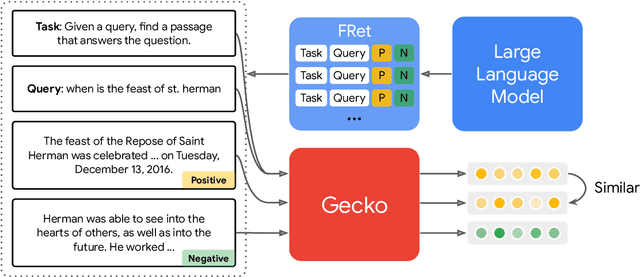


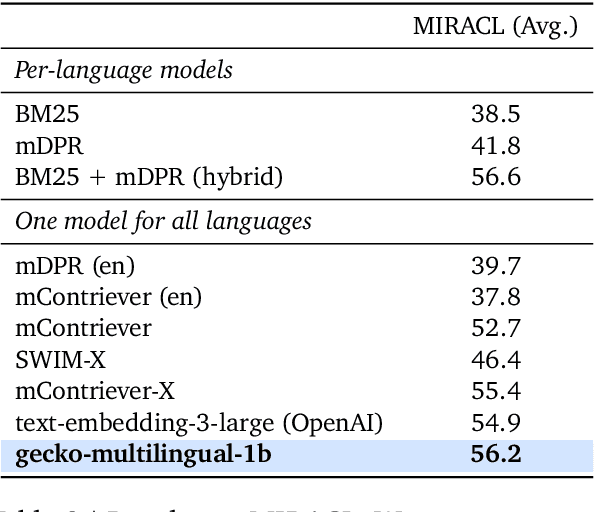
Abstract:We present Gecko, a compact and versatile text embedding model. Gecko achieves strong retrieval performance by leveraging a key idea: distilling knowledge from large language models (LLMs) into a retriever. Our two-step distillation process begins with generating diverse, synthetic paired data using an LLM. Next, we further refine the data quality by retrieving a set of candidate passages for each query, and relabeling the positive and hard negative passages using the same LLM. The effectiveness of our approach is demonstrated by the compactness of the Gecko. On the Massive Text Embedding Benchmark (MTEB), Gecko with 256 embedding dimensions outperforms all existing entries with 768 embedding size. Gecko with 768 embedding dimensions achieves an average score of 66.31, competing with 7x larger models and 5x higher dimensional embeddings.
MagicLens: Self-Supervised Image Retrieval with Open-Ended Instructions
Mar 28, 2024



Abstract:Image retrieval, i.e., finding desired images given a reference image, inherently encompasses rich, multi-faceted search intents that are difficult to capture solely using image-based measures. Recent work leverages text instructions to allow users to more freely express their search intents. However, existing work primarily focuses on image pairs that are visually similar and/or can be characterized by a small set of pre-defined relations. The core thesis of this paper is that text instructions can enable retrieving images with richer relations beyond visual similarity. To show this, we introduce MagicLens, a series of self-supervised image retrieval models that support open-ended instructions. MagicLens is built on a key novel insight: image pairs that naturally occur on the same web pages contain a wide range of implicit relations (e.g., inside view of), and we can bring those implicit relations explicit by synthesizing instructions via large multimodal models (LMMs) and large language models (LLMs). Trained on 36.7M (query image, instruction, target image) triplets with rich semantic relations mined from the web, MagicLens achieves comparable or better results on eight benchmarks of various image retrieval tasks than prior state-of-the-art (SOTA) methods. Remarkably, it outperforms previous SOTA but with a 50X smaller model size on multiple benchmarks. Additional human analyses on a 1.4M-image unseen corpus further demonstrate the diversity of search intents supported by MagicLens.
Instruct-Imagen: Image Generation with Multi-modal Instruction
Jan 03, 2024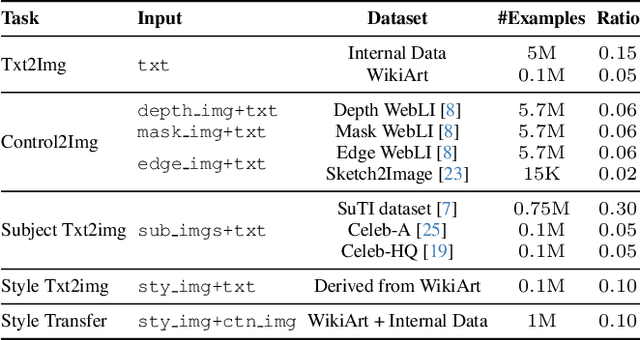
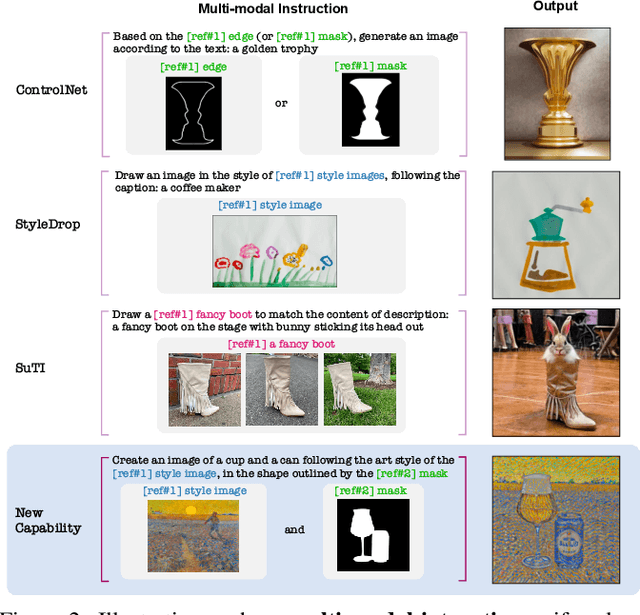

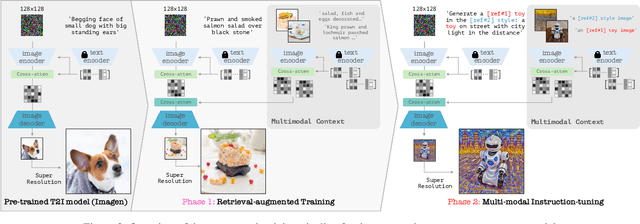
Abstract:This paper presents instruct-imagen, a model that tackles heterogeneous image generation tasks and generalizes across unseen tasks. We introduce *multi-modal instruction* for image generation, a task representation articulating a range of generation intents with precision. It uses natural language to amalgamate disparate modalities (e.g., text, edge, style, subject, etc.), such that abundant generation intents can be standardized in a uniform format. We then build instruct-imagen by fine-tuning a pre-trained text-to-image diffusion model with a two-stage framework. First, we adapt the model using the retrieval-augmented training, to enhance model's capabilities to ground its generation on external multimodal context. Subsequently, we fine-tune the adapted model on diverse image generation tasks that requires vision-language understanding (e.g., subject-driven generation, etc.), each paired with a multi-modal instruction encapsulating the task's essence. Human evaluation on various image generation datasets reveals that instruct-imagen matches or surpasses prior task-specific models in-domain and demonstrates promising generalization to unseen and more complex tasks.
Gemini: A Family of Highly Capable Multimodal Models
Dec 19, 2023Abstract:This report introduces a new family of multimodal models, Gemini, that exhibit remarkable capabilities across image, audio, video, and text understanding. The Gemini family consists of Ultra, Pro, and Nano sizes, suitable for applications ranging from complex reasoning tasks to on-device memory-constrained use-cases. Evaluation on a broad range of benchmarks shows that our most-capable Gemini Ultra model advances the state of the art in 30 of 32 of these benchmarks - notably being the first model to achieve human-expert performance on the well-studied exam benchmark MMLU, and improving the state of the art in every one of the 20 multimodal benchmarks we examined. We believe that the new capabilities of Gemini models in cross-modal reasoning and language understanding will enable a wide variety of use cases and we discuss our approach toward deploying them responsibly to users.
QUEST: A Retrieval Dataset of Entity-Seeking Queries with Implicit Set Operations
May 19, 2023



Abstract:Formulating selective information needs results in queries that implicitly specify set operations, such as intersection, union, and difference. For instance, one might search for "shorebirds that are not sandpipers" or "science-fiction films shot in England". To study the ability of retrieval systems to meet such information needs, we construct QUEST, a dataset of 3357 natural language queries with implicit set operations, that map to a set of entities corresponding to Wikipedia documents. The dataset challenges models to match multiple constraints mentioned in queries with corresponding evidence in documents and correctly perform various set operations. The dataset is constructed semi-automatically using Wikipedia category names. Queries are automatically composed from individual categories, then paraphrased and further validated for naturalness and fluency by crowdworkers. Crowdworkers also assess the relevance of entities based on their documents and highlight attribution of query constraints to spans of document text. We analyze several modern retrieval systems, finding that they often struggle on such queries. Queries involving negation and conjunction are particularly challenging and systems are further challenged with combinations of these operations.
Subject-driven Text-to-Image Generation via Apprenticeship Learning
Apr 14, 2023Abstract:Recent text-to-image generation models like DreamBooth have made remarkable progress in generating highly customized images of a target subject, by fine-tuning an ``expert model'' for a given subject from a few examples. However, this process is expensive, since a new expert model must be learned for each subject. In this paper, we present SuTI, a Subject-driven Text-to-Image generator that replaces subject-specific fine tuning with \emph{in-context} learning. Given a few demonstrations of a new subject, SuTI can instantly generate novel renditions of the subject in different scenes, without any subject-specific optimization. SuTI is powered by {\em apprenticeship learning}, where a single apprentice model is learned from data generated by massive amount of subject-specific expert models. Specifically, we mine millions of image clusters from the Internet, each centered around a specific visual subject. We adopt these clusters to train massive amount of expert models specialized on different subjects. The apprentice model SuTI then learns to mimic the behavior of these experts through the proposed apprenticeship learning algorithm. SuTI can generate high-quality and customized subject-specific images 20x faster than optimization-based SoTA methods. On the challenging DreamBench and DreamBench-v2, our human evaluation shows that SuTI can significantly outperform existing approaches like InstructPix2Pix, Textual Inversion, Imagic, Prompt2Prompt, Re-Imagen while performing on par with DreamBooth.
Conditional Adapters: Parameter-efficient Transfer Learning with Fast Inference
Apr 11, 2023Abstract:We propose Conditional Adapter (CoDA), a parameter-efficient transfer learning method that also improves inference efficiency. CoDA generalizes beyond standard adapter approaches to enable a new way of balancing speed and accuracy using conditional computation. Starting with an existing dense pretrained model, CoDA adds sparse activation together with a small number of new parameters and a light-weight training phase. Our experiments demonstrate that the CoDA approach provides an unexpectedly efficient way to transfer knowledge. Across a variety of language, vision, and speech tasks, CoDA achieves a 2x to 8x inference speed-up compared to the state-of-the-art Adapter approach with moderate to no accuracy loss and the same parameter efficiency.
 Add to Chrome
Add to Chrome Add to Firefox
Add to Firefox Add to Edge
Add to Edge